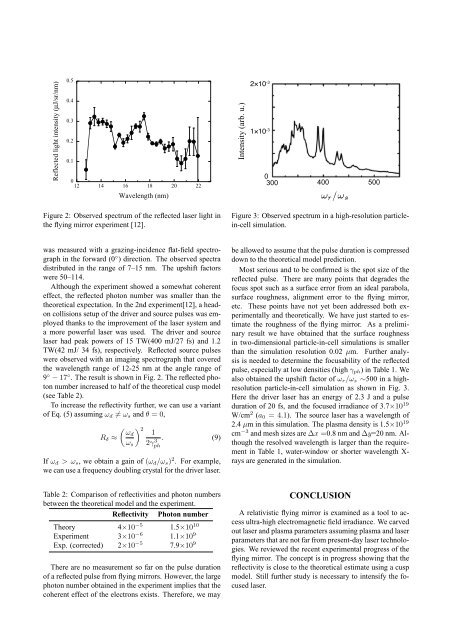Proceedings of International Conference on Physics in ... - KEK
Proceedings of International Conference on Physics in ... - KEK
Proceedings of International Conference on Physics in ... - KEK
You also want an ePaper? Increase the reach of your titles
YUMPU automatically turns print PDFs into web optimized ePapers that Google loves.
Reflected light <strong>in</strong>tensity (μJ/sr/nm)<br />
0.5<br />
0.4<br />
0.3<br />
0.2<br />
0.1<br />
0<br />
12 14 16 18 20 22<br />
Wavelength (nm)<br />
Figure 2: Observed spectrum <str<strong>on</strong>g>of</str<strong>on</strong>g> the reflected laser light <strong>in</strong><br />
the fly<strong>in</strong>g mirror experiment [12].<br />
was measured with a graz<strong>in</strong>g-<strong>in</strong>cidence flat-field spectrograph<br />
<strong>in</strong> the forward (0 ◦ ) directi<strong>on</strong>. The observed spectra<br />
distributed <strong>in</strong> the range <str<strong>on</strong>g>of</str<strong>on</strong>g> 7–15 nm. The upshift factors<br />
were 50–114.<br />
Although the experiment showed a somewhat coherent<br />
effect, the reflected phot<strong>on</strong> number was smaller than the<br />
theoretical expectati<strong>on</strong>. In the 2nd experiment[12], a head<strong>on</strong><br />
collisi<strong>on</strong>s setup <str<strong>on</strong>g>of</str<strong>on</strong>g> the driver and source pulses was employed<br />
thanks to the improvement <str<strong>on</strong>g>of</str<strong>on</strong>g> the laser system and<br />
a more powerful laser was used. The driver and source<br />
laser had peak powers <str<strong>on</strong>g>of</str<strong>on</strong>g> 15 TW(400 mJ/27 fs) and 1.2<br />
TW(42 mJ/ 34 fs), respectively. Reflected source pulses<br />
were observed with an imag<strong>in</strong>g spectrograph that covered<br />
the wavelength range <str<strong>on</strong>g>of</str<strong>on</strong>g> 12-25 nm at the angle range <str<strong>on</strong>g>of</str<strong>on</strong>g><br />
9 ◦ − 17 ◦ . The result is shown <strong>in</strong> Fig. 2. The reflected phot<strong>on</strong><br />
number <strong>in</strong>creased to half <str<strong>on</strong>g>of</str<strong>on</strong>g> the theoretical cusp model<br />
(see Table 2).<br />
To <strong>in</strong>crease the reflectivity further, we can use a variant<br />
<str<strong>on</strong>g>of</str<strong>on</strong>g> Eq. (5) assum<strong>in</strong>g ωd ̸= ωs and θ = 0,<br />
Rδ ≈<br />
( ) 2<br />
ωd 1<br />
ωs 2γ3 ph<br />
. (9)<br />
If ωd > ωs, we obta<strong>in</strong> a ga<strong>in</strong> <str<strong>on</strong>g>of</str<strong>on</strong>g> (ωd/ωs) 2 . For example,<br />
we can use a frequency doubl<strong>in</strong>g crystal for the driver laser.<br />
Table 2: Comparis<strong>on</strong> <str<strong>on</strong>g>of</str<strong>on</strong>g> reflectivities and phot<strong>on</strong> numbers<br />
between the theoretical model and the experiment.<br />
Reflectivity Phot<strong>on</strong> number<br />
Theory 4×10 −5 1.5×10 10<br />
Experiment 3×10 −6 1.1×10 9<br />
Exp. (corrected) 2×10 −5 7.9×10 9<br />
There are no measurement so far <strong>on</strong> the pulse durati<strong>on</strong><br />
<str<strong>on</strong>g>of</str<strong>on</strong>g> a reflected pulse from fly<strong>in</strong>g mirrors. However, the large<br />
phot<strong>on</strong> number obta<strong>in</strong>ed <strong>in</strong> the experiment implies that the<br />
coherent effect <str<strong>on</strong>g>of</str<strong>on</strong>g> the electr<strong>on</strong>s exists. Therefore, we may<br />
Intensity (arb. u.)<br />
-3<br />
-3<br />
0<br />
300 400 500<br />
Figure 3: Observed spectrum <strong>in</strong> a high-resoluti<strong>on</strong> particle<strong>in</strong>-cell<br />
simulati<strong>on</strong>.<br />
be allowed to assume that the pulse durati<strong>on</strong> is compressed<br />
down to the theoretical model predicti<strong>on</strong>.<br />
Most serious and to be c<strong>on</strong>firmed is the spot size <str<strong>on</strong>g>of</str<strong>on</strong>g> the<br />
reflected pulse. There are many po<strong>in</strong>ts that degrades the<br />
focus spot such as a surface error from an ideal parabola,<br />
surface roughness, alignment error to the fly<strong>in</strong>g mirror,<br />
etc. These po<strong>in</strong>ts have not yet been addressed both experimentally<br />
and theoretically. We have just started to estimate<br />
the roughness <str<strong>on</strong>g>of</str<strong>on</strong>g> the fly<strong>in</strong>g mirror. As a prelim<strong>in</strong>ary<br />
result we have obta<strong>in</strong>ed that the surface roughness<br />
<strong>in</strong> two-dimensi<strong>on</strong>al particle-<strong>in</strong>-cell simulati<strong>on</strong>s is smaller<br />
than the simulati<strong>on</strong> resoluti<strong>on</strong> 0.02 µm. Further analysis<br />
is needed to determ<strong>in</strong>e the focusability <str<strong>on</strong>g>of</str<strong>on</strong>g> the reflected<br />
pulse, especially at low densities (high γph) <strong>in</strong> Table 1. We<br />
also obta<strong>in</strong>ed the upshift factor <str<strong>on</strong>g>of</str<strong>on</strong>g> ωr/ωs ∼500 <strong>in</strong> a highresoluti<strong>on</strong><br />
particle-<strong>in</strong>-cell simulati<strong>on</strong> as shown <strong>in</strong> Fig. 3.<br />
Here the driver laser has an energy <str<strong>on</strong>g>of</str<strong>on</strong>g> 2.3 J and a pulse<br />
durati<strong>on</strong> <str<strong>on</strong>g>of</str<strong>on</strong>g> 20 fs, and the focused irradiance <str<strong>on</strong>g>of</str<strong>on</strong>g> 3.7×10 19<br />
W/cm 2 (a0 = 4.1). The source laser has a wavelength <str<strong>on</strong>g>of</str<strong>on</strong>g><br />
2.4 µm <strong>in</strong> this simulati<strong>on</strong>. The plasma density is 1.5×10 19<br />
cm −3 and mesh sizes are ∆x =0.8 nm and ∆y=20 nm. Although<br />
the resolved wavelength is larger than the requirement<br />
<strong>in</strong> Table 1, water-w<strong>in</strong>dow or shorter wavelength Xrays<br />
are generated <strong>in</strong> the simulati<strong>on</strong>.<br />
CONCLUSION<br />
A relativistic fly<strong>in</strong>g mirror is exam<strong>in</strong>ed as a tool to access<br />
ultra-high electromagnetic field irradiance. We carved<br />
out laser and plasma parameters assum<strong>in</strong>g plasma and laser<br />
parameters that are not far from present-day laser technologies.<br />
We reviewed the recent experimental progress <str<strong>on</strong>g>of</str<strong>on</strong>g> the<br />
fly<strong>in</strong>g mirror. The c<strong>on</strong>cept is <strong>in</strong> progress show<strong>in</strong>g that the<br />
reflectivity is close to the theoretical estimate us<strong>in</strong>g a cusp<br />
model. Still further study is necessary to <strong>in</strong>tensify the focused<br />
laser.













